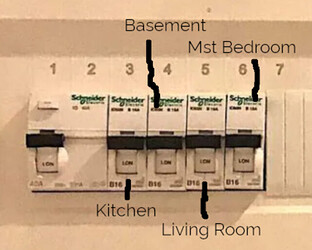Hi,
I just bought a Devolo power line set (2 devolo devices). I plugged them directly into wall outlets and connected one with my router and one with my laptop via a RJ45-USB-C adapter, because the laptop hasn’t a built-in RJ45 slot.
TL;DR
The Laptop (using a RJ45-to-USB-C adapter) doesn’t connect via the power line devices to the router. According to the ethernet settings the ethernet cable isn’t plugged.
Power Line Set-Up:
Router ◄───► RJ45 ◄─────► Power Line Adapter
▲
┌───► Power Line ◄──────────┘
▼
Power Line Adapter ◄───► RJ45 ◄───► RJ45-to-USB-C Adapter (Anker)
▲
┌────────────────────────────────────┘
▼
USB-C ◄───────► Laptop
The Problem
After plugging everything in, the devices blinked red, then white. That’s—according to the manufacturer’s manual—the confirmation that the power line devices found themselves and connected securely.
I, then, looked into the network manager, and it said:
I then disabled the Wi-Fi, but it still said, the cable is unplugged.
How do I set up the connection?
Inxi
System:
Kernel: 5.10.84-1-MANJARO x86_64 bits: 64 compiler: gcc v: 11.1.0
parameters: BOOT_IMAGE=/boot/vmlinuz-5.10-x86_64
root=UUID=b87ec433-16bf-406f-8eb6-1515bfe7e05a rw quiet
udev.log_priority=3 sysrq_always_enabled=1
Desktop: GNOME 41.2 tk: GTK 3.24.30 wm: gnome-shell dm: GDM 41.0
Distro: Manjaro Linux base: Arch Linux
Machine:
Type: Laptop System: Dell product: XPS 17 9700 v: N/A
serial: <superuser required> Chassis: type: 10 serial: <superuser required>
Mobo: Dell model: 0H7HN7 v: A00 serial: <superuser required> UEFI: Dell
v: 1.8.2 date: 05/21/2021
Network:
Device-1: Intel Comet Lake PCH CNVi WiFi vendor: Rivet Networks
driver: iwlwifi v: kernel bus-ID: 00:14.3 chip-ID: 8086:06f0 class-ID: 0280
IF: wlp0s20f3 state: up mac: <filter>
IP v4: <filter> type: dynamic noprefixroute scope: global
broadcast: <filter>
IP v6: <filter> type: dynamic noprefixroute scope: global
IP v6: <filter> type: dynamic noprefixroute scope: global
IP v6: <filter> type: noprefixroute scope: link
Device-2: Realtek RTL8153 Gigabit Ethernet Adapter type: USB driver: r8152
bus-ID: 4-2:3 chip-ID: 0bda:8153 class-ID: 0000 serial: <filter>
IF: enp58s0u2 state: down mac: <filter>
WAN IP: <filter>
USB:
Hub-1: 1-0:1 info: Hi-speed hub with single TT ports: 16 rev: 2.0
speed: 480 Mb/s chip-ID: 1d6b:0002 class-ID: 0900
Device-1: 1-1:2 info: Shenzhen Goodix FingerPrint type: <vendor specific>
driver: N/A interfaces: 1 rev: 2.0 speed: 12 Mb/s power: 100mA
chip-ID: 27c6:533c class-ID: ff00
Hub-2: 1-2:3 info: VIA Labs USB2.0 Hub ports: 4 rev: 2.1 speed: 480 Mb/s
chip-ID: 2109:2211 class-ID: 0900
Device-1: 1-2.2:6 info: Dell Dell DA20 Adapter type: Billboard driver: N/A
interfaces: 1 rev: 2.0 speed: 12 Mb/s chip-ID: 413c:b080 class-ID: 1100
serial: <filter>
Device-2: 1-5:4 info: Microdia Integrated_Webcam_HD type: Video
driver: uvcvideo interfaces: 4 rev: 2.0 speed: 480 Mb/s power: 500mA
chip-ID: 0c45:6a0c class-ID: 0e02
Device-3: 1-14:5 info: Intel AX201 Bluetooth type: Bluetooth driver: btusb
interfaces: 2 rev: 2.0 speed: 12 Mb/s power: 100mA chip-ID: 8087:0026
class-ID: e001
Hub-3: 2-0:1 info: Super-speed hub ports: 10 rev: 3.1 speed: 10 Gb/s
chip-ID: 1d6b:0003 class-ID: 0900
Hub-4: 3-0:1 info: Hi-speed hub with single TT ports: 2 rev: 2.0
speed: 480 Mb/s chip-ID: 1d6b:0002 class-ID: 0900
Hub-5: 4-0:1 info: Super-speed hub ports: 2 rev: 3.1 speed: 10 Gb/s
chip-ID: 1d6b:0003 class-ID: 0900
Device-1: 4-2:3 info: Realtek RTL8153 Gigabit Ethernet Adapter
type: Network driver: r8152 interfaces: 1 rev: 3.0 speed: 5 Gb/s
power: 288mA chip-ID: 0bda:8153 class-ID: 0000 serial: <filter>
Hub-6: 5-0:1 info: Hi-speed hub with single TT ports: 2 rev: 2.0
speed: 480 Mb/s chip-ID: 1d6b:0002 class-ID: 0900
Hub-7: 6-0:1 info: Super-speed hub ports: 2 rev: 3.1 speed: 10 Gb/s
chip-ID: 1d6b:0003 class-ID: 0900
Hub-8: 6-2:2 info: VIA Labs USB3.0 Hub ports: 1 rev: 3.1 speed: 5 Gb/s
chip-ID: 2109:0211 class-ID: 0900
NetworkManager
$ sudo cat /etc/NetworkManager/system-connections/Ethernet.nmconnection
[connection]
id=Ethernet
uuid=${UUID}
type=ethernet
permissions=
[ethernet]
mac-address-blacklist=
[ipv4]
dns-search=
method=auto
[ipv6]
addr-gen-mode=stable-privacy
dns-search=
method=auto
[proxy]

